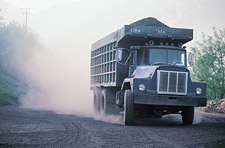- Like
- Digg
- Del
- Tumblr
- VKontakte
- Buffer
- Love This
- Odnoklassniki
- Meneame
- Blogger
- Amazon
- Yahoo Mail
- Gmail
- AOL
- Newsvine
- HackerNews
- Evernote
- MySpace
- Mail.ru
- Viadeo
- Line
- Comments
- Yummly
- SMS
- Viber
- Telegram
- Subscribe
- Skype
- Facebook Messenger
- Kakao
- LiveJournal
- Yammer
- Edgar
- Fintel
- Mix
- Instapaper
- Copy Link
(Citation and Accident Data is below text)
During the 2003 legislative session several bills pertaining to overweight coal trucks were introduced. HB 2067, which was introduced and sponsored by Delegate Caputo, would have required law enforcement officers investigating accidents involving commercial motor vehicles to include the weight of those vehicles in accident reports.
If this legislation had passed it would have made it easier for the Division of Highways to determine how many overweight vehicles are involved in accidents. On a number of occasions when DOH officials have been asked how many overweight vehicles were involved in accidents they were unable to provide an answer. They were also unable to accurately determine how many coal trucks were involved in accidents because currently, investigating officers are not required to report what commercial vehicles are hauling.
Unfortunately, as we all know, coal trucks are involved in accidents far too often. The DOH determined that there were 8 coal truck accidents resulting in 11 fatalities in 2000 and 2001, according to a summary of coal truck accidents released by the agency. Research released by Coal River Mountain Watch in January 2003 uncovered 5 additional coal truck related deaths that were not included in either the DOH summary or in a review of coal truck accidents conducted by the Natural Resource Haulers Association.
The coal haulers tried to use the DOH records to their advantage, but their report reinforces why we must continue to pressure Governor Wise and the Legislature to crackdown on outlaw coal haulers. “This is what they didn’t want you to see.” said Judy Bonds of CRMW. Bonds said the report was an attempt by the industry to divert attention from the real issue – safety. “The truckers association point to fault in these fatal crashes. Almost always, only one side of the story is ever heard.”
A closer look at the coal haulers own data reveals what coalfield residents and activist have been saying all along -that these trucks are dangerous. They are more likely to roll over and they are often poorly maintained. CRMW cited numerous incidents of trucks rolling over, knocking mirrors off a school bus, striking passenger vehicles, drive lines falling off and tires blowing out. In some instances the driver of the coal truck was cited for failure to maintain control, but in many cases there was no citation issued.
The coal industry line is that it will be crippled if coal trucks can’t run at 120,000 pounds or more, but this just isn’t so. A review of citations issued to overweight coal trucks conducted by West Virginia Citizen Action Group revealed a major discrepancy between trucks in the northern and southern parts of the state even though a considerable amount of coal is mined in both regions. Although the problem with overweight coal trucks is not limited to the southern counties, the heaviest trucks are concentrated there. WV-CAG’s research was based on citations issued by the DOH from January 2000 through June 2002.
The average weight of coal trucks cited in Kanawha County was 144,752 pounds. In 2000, 14,776,832 tons of coal was mined in Kanawha County. That same year nearly 12 million tons of coal was mined in Monongalia County, but the average weight of coal trucks there was only 82,932 pounds. Considering this, the industry’s argument doesn’t carry any weight.
Truck Citation and Accident Data
January 2000 – June 2002
(pdf format)
Citations Issued to Overweight Coal Trucks By Weight Range & County
Citations Issued to Overweight Trucks And Coal Production By County

